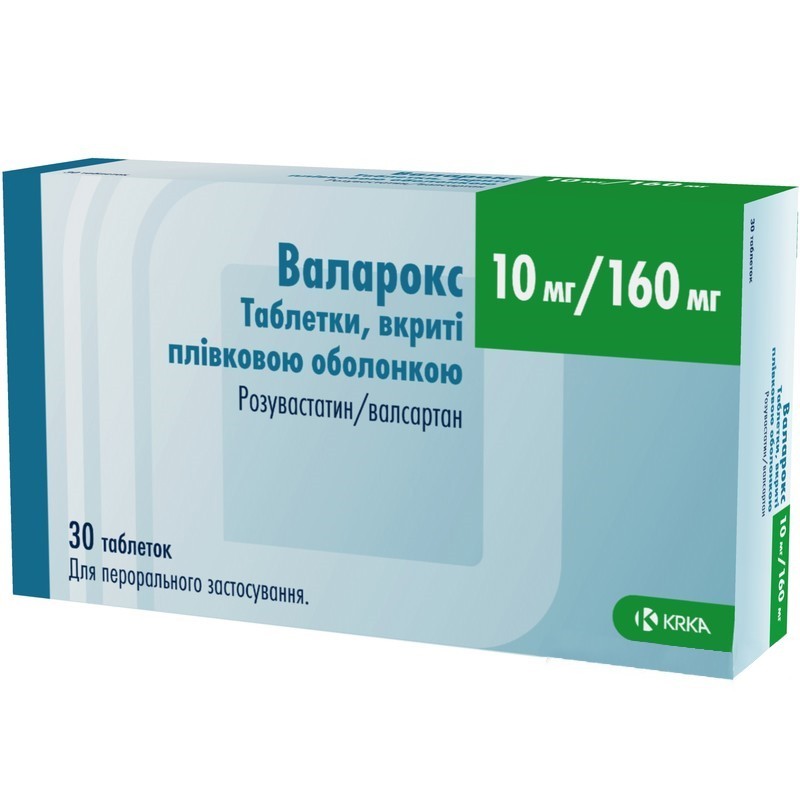



 Secure and encrypted payment processing
Secure and encrypted payment processing We ship to over 40 countries including the USA, UK, Europe, Australia and Japan
We ship to over 40 countries including the USA, UK, Europe, Australia and Japan Guaranteed refund or reship if you haven't received your order
Guaranteed refund or reship if you haven't received your orderValarox is indicated as a substitution therapy for arterial hypertension in adult patients whose condition is properly controlled by the simultaneous use of valsartan and rosuvastatin at the same dosages and having a high risk of the first occurrence of cardiovascular complications (for the prevention of cardiovascular complications) or under the following conditions:
Active ingredient: rosuvastatin, valsartan;
1 coated tablet contains 10 mg of rosuvastatin in the form of rosuvastatin calcium and 160 mg of valsartan;
Excipients: microcrystalline cellulose (type 102), lactose, croscarmellose sodium, colloidal silicon dioxide, magnesium stearate, mannitol (E 421), povidone K 25, sodium lauryl sulfate, yellow iron oxide (E172);
Film coating: polyvinyl alcohol, titanium dioxide (E 171), macrogol 3000, talc, red iron oxide (E172) (except for the dosage of 20 mg / 160 mg), yellow iron oxide (E172) (except for the dosage of 20 mg / 80 mg and 10 mg / 80 mg).
Before starting treatment, the patient must be prescribed a standard hypocholesterolemic diet, which he must adhere to during treatment.
The recommended dose of Valarox is 1 tablet per day.
A fixed combination is not suitable for initial therapy.
Prior to the transition to Valarox, the condition of patients should be monitored by stable doses of the individual components with simultaneous use. The dose of Valarox should be based on the doses of the individual components of the combination at the time of transition.
If a change in the dose of any active substance of a fixed combination is required for any reason (for example, a disease is first diagnosed, a change in the patients condition or drug interactions), the individual components must be reused to determine the dose.
Contraindicated.
Contraindicated.
Carefully.
Symptoms Overdose of valzartan can result in severe arterial hypotension, which can lead to depression of consciousness, vascular insufficiency and / or shock.
Treatment. Therapeutic measures depend on the time of taking the excessive dose, the type and severity of the symptoms, stabilization of the circulatory state is of paramount importance.
If arterial hypotension occurs, the patient should be in a prone position, and blood volume should also be corrected.
It is unlikely that valsartan can be eliminated by hemodialysis. The benefits of hemodialysis are unlikely.
There is no specific treatment in case of overdose. The treatment is symptomatic. If necessary, take supporting activities. You should check the level of CPK and conduct tests to assess the functional state of the liver.
Lithium. A temporary increase in serum lithium concentration and toxicity have been reported while taking lithium and ACE inhibitors. If the need for a combination has been proven, careful monitoring of plasma lithium levels is recommended.
Potassium-sparing diuretics, potassium supplements, salt substitutes containing potassium, or other drugs that can increase potassium levels. If there is a need for taking the drug, it affects the level of potassium, in combination with valsartan, it is recommended to monitor the level of potassium in the blood plasma.
The drug does not require special temperature storage conditions.
Store in the original packaging to protect from moisture.
Keep out of the reach of children.
Shelf life is 2 years.